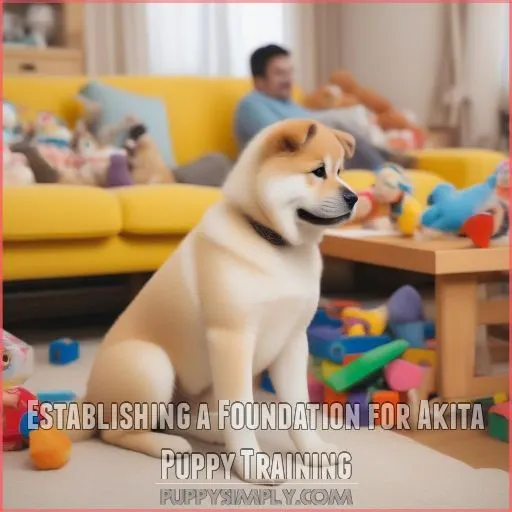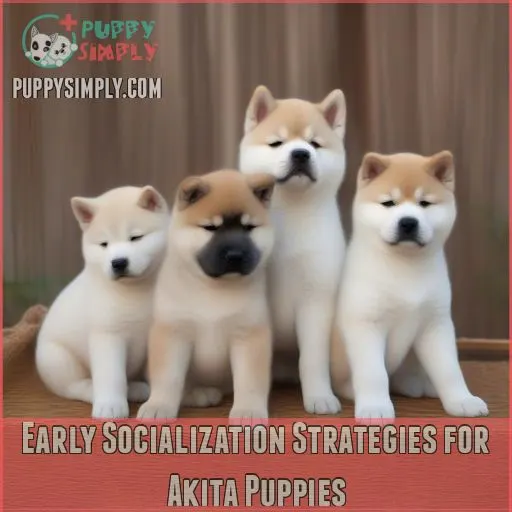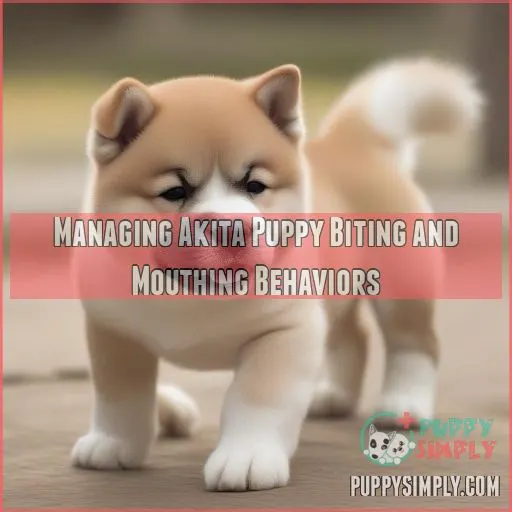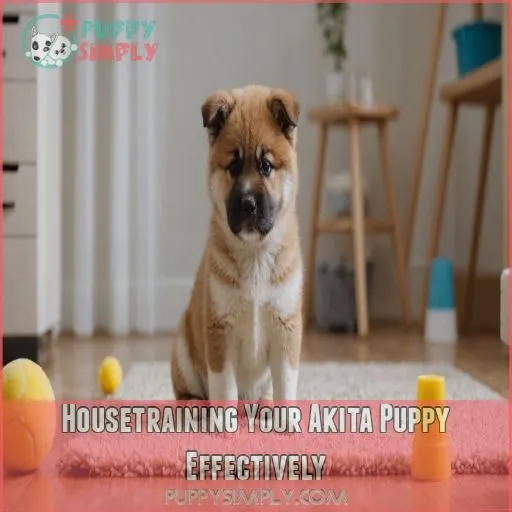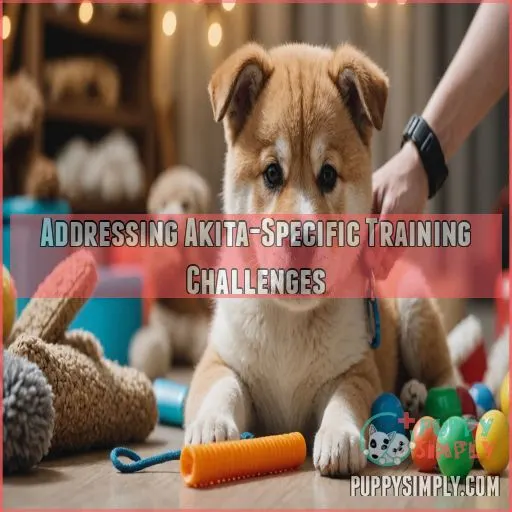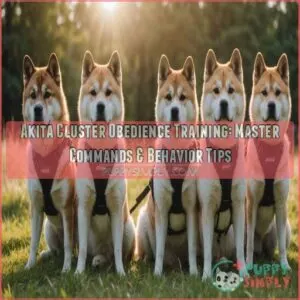This site is supported by our readers. We may earn a commission, at no cost to you, if you purchase through links.
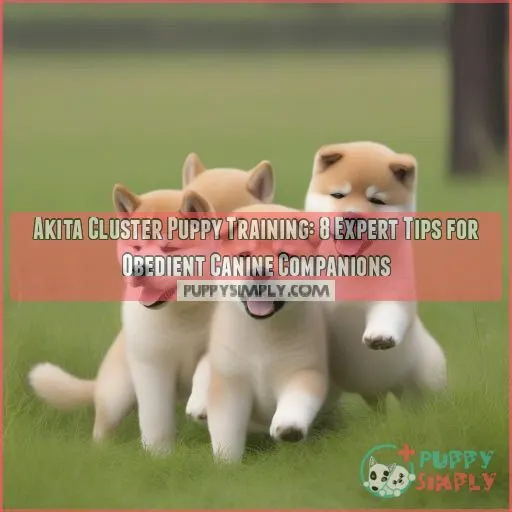
Start by creating a safe, loving environment and establishing clear boundaries.
Teach essential commands like "sit," "stay," and "come" using high-value treats and short, fun sessions.
Address biting and mouthing behaviors early on, redirecting to appropriate toys.
Don’t forget potty training – consistency is key!
As your Akita grows, you’ll face unique challenges like their independent streak and territorial tendencies.
But with patience and the right approach, you’ll be amazed at how quickly your furry samurai transforms into a well-behaved companion.
Table Of Contents
- Key Takeaways
- Establishing a Foundation for Akita Puppy Training
- Early Socialization Strategies for Akita Puppies
- Essential Commands for Akita Cluster Training
- Managing Akita Puppy Biting and Mouthing Behaviors
- Housetraining Your Akita Puppy Effectively
- Crate Training for Akita Cluster Puppies
- Addressing Akita-Specific Training Challenges
- Advanced Training for Growing Akita Puppies
- Frequently Asked Questions (FAQs)
- Are Akita puppies easy to train?
- How many puppies can an Akita have in a litter?
- How do you train an Akita dominance?
- How do I get my Akita puppy to stop biting?
- How to prevent resource guarding in Akita puppies?
- Best techniques for leash training an Akita puppy?
- Managing Akita puppy energy levels and exercise needs?
- Introducing Akita puppies to other pets safely?
- Grooming routines and coat care for Akita puppies?
- Conclusion
Key Takeaways
- You’ll want to start early with socialization and obedience work – think of it as giving your furry samurai a head start in life. Expose them to different people, places, and experiences to build their confidence and prevent future behavioral issues.
- Consistency is your secret weapon in training your Akita pup. They’re smart cookies, but they can be as stubborn as a mule. Stick to your guns, use positive reinforcement, and you’ll be amazed at how quickly they catch on.
- Don’t forget to address those sharp puppy teeth! Redirect biting to appropriate toys and teach bite inhibition. Remember, your hands aren’t chew toys – unless you’re going for the "living pincushion" look.
- You’ll need to keep your Akita’s strong-willed nature in check. Establish yourself as the pack leader through clear boundaries and positive reinforcement. It’s not about dominating your pup, but rather building a relationship based on mutual respect and trust.
Establishing a Foundation for Akita Puppy Training
Ready to start the rewarding journey of Akita puppy training?
You’ll find success by starting with a solid foundation that focuses on creating a loving environment,
building a strong bond,
and using positive reinforcement techniques to shape your furry friend’s behavior.
Creating a Safe and Loving Environment
When you bring your Akita puppy home, it’s time to roll out the red carpet—puppy style!
Start by puppy-proofing your space, removing hazards and creating a safe haven for your furry friend.
Set up a cozy corner with a comfy bed, toys, and water.
Keep the energy calm and positive, laying the groundwork for successful training.
Building a Strong Human-Puppy Bond
Building a strong bond with your Akita puppy is really important for successful training.
Spend quality time together through puppy play and positive touch.
Establish trust by offering consistent care and affection.
Create a routine that includes feeding, potty breaks, and cuddle sessions.
Use gentle handling and soothing tones to comfort your pup.
Remember, early bonding lays the foundation for a lifelong partnership with your furry friend.
Setting Clear Structure and Boundaries
Clear boundaries are the cornerstone of a well-behaved Akita pup.
You’ll want to establish consistent routines from day one.
Set up a cozy crate as your furry friend’s safe haven.
Define play areas and no-go zones in your home.
Teach your pup what’s acceptable – like chewing toys, not shoes.
Implementing Positive Reinforcement Techniques
Positive reinforcement is the cornerstone of successful Akita puppy training.
You’ll find that rewarding good behavior yields better results than punishing mistakes.
Here are three key techniques to implement:
- Treat-based rewards for desired actions
- Clicker training to mark precise moments of success
- Enthusiastic praise and affection to reinforce bonds
Developing Trust and Communication
Now that you’ve embraced positive reinforcement, let’s focus on developing trust with your Akita puppy.
Communication is a two-way street, so pay attention to your pup’s body language. Is their tail wagging? Are they making eye contact? These are signs they’re trying to "talk" to you!
Spend quality time playing and cuddling to strengthen your bond. Remember, every positive interaction is like adding a brick to the foundation of your relationship.
Early Socialization Strategies for Akita Puppies
With your Akita puppy’s foundation set, it’s time to open their world. Early socialization is your ticket to a well-adjusted adult dog. Start by introducing your furry friend to a smorgasbord of experiences. Take them on short trips to bustling parks, quiet streets, and even your local pet store. Let them soak in the sights, sounds, and smells of their new world.
Arrange puppy playdates or join puppy classes to help your Akita learn proper canine etiquette. Remember, their temperament can be a bit standoffish, so keep interactions positive and reward friendly behavior. Don’t forget to expose them to various surfaces, from grass to concrete, and different weather conditions.
If your pup shows signs of fear, don’t force the issue. Instead, create positive associations with treats and praise. Your goal? A confident Akita who takes life’s surprises in stride.
Essential Commands for Akita Cluster Training
You’re about to start the exciting journey of teaching your Akita puppy essential commands.
From mastering "sit" and "stay" to perfecting loose-leash walking, these foundational skills will set your furry friend up for a lifetime of good behavior and strengthen your bond.
Teaching Sit, Stay, and Down
Now that your Akita puppy is getting comfortable with new experiences, it’s time to tackle basic obedience. Teaching "sit," "stay," and "down" lays the groundwork for more advanced training. Remember, Akitas are smart but can be stubborn, so patience is key!
Here are some tips to make training a breeze:
- Use high-value treats as motivation
- Keep sessions short and fun
- Practice in different locations
- Celebrate small victories
Mastering Come and Recall Training
For Akita puppies, mastering the "come" command is really important for their safety and your peace of mind.
Start in a distraction-free zone, using a cheerful voice and high-value treats.
Gradually increase difficulty by adding distractions.
| Stage | Environment | Reward |
|---|---|---|
| Beginner | Indoors | Treats |
| Intermediate | Backyard | Toys |
| Advanced | Park | Praise |
| Expert | Beach | Play time |
Always celebrate your pup’s success – they’re learning to be your furry boomerang!
Introducing Leave It and Drop It
Teaching your Akita pup "leave it" and "drop it" can be a lifesaver – literally!
Start with low-value items and gradually increase difficulty.
Hold a treat in your closed fist, saying "leave it" when your pup investigates.
Reward with a better treat from your other hand when they back off.
For "drop it", offer a trade-up for forbidden objects.
Consistency and patience are key to mastering these important commands.
Leash Training and Loose-Leash Walking
Leash training your Akita puppy can be a walk in the park with the right approach.
Start early and be consistent to prevent your furry freight train from pulling you down the street.
Here are some tips to make your walks more enjoyable:
- Use a sturdy harness designed for large breeds
- Reward your pup for walking calmly by your side
- Stop walking immediately if they pull, then redirect
- Practice in low-distraction areas before venturing out
Impulse Control Exercises
Impulse control is key to raising a well-behaved Akita.
You’ll want to kick things off with the "leave it" command, teaching your pup to resist temptation.
Next, work on "wait" at doorways and before meals.
Gradually increase difficulty by adding distractions.
Managing Akita Puppy Biting and Mouthing Behaviors
You’ve got an adorable Akita puppy, but those sharp little teeth are starting to become a problem.
Don’t worry – with the right techniques, you can teach your furry friend to use their mouth gently and redirect that nippy behavior into more appropriate outlets.
Redirecting Biting to Appropriate Toys
Now that your Akita pup’s mastered basic commands, let’s tackle those razor-sharp teeth! Redirecting biting to toys isn’t just about saving your furniture (and fingers). It’s a game-changer for your pup’s development.
Here are some puppy-approved strategies:
- Offer a variety of enticing chew toys
- Swap your hand for a toy when playtime gets too rough
- Praise and reward gentle play with toys
Teaching Bite Inhibition Through Play
Regularly engage your Akita puppy in gentle play sessions to teach bite inhibition. When those sharp puppy teeth make contact, yelp like a hurt littermate to signal discomfort. This mimics natural pack behavior and helps your pup learn soft mouths.
Here’s a quick guide to bite inhibition play:
| Puppy Action | Your Response | Desired Outcome |
|---|---|---|
| Soft mouthing | Continue play | Reinforces gentle touch |
| Medium bite | Brief yelp, pause play | Teaches bite control |
| Hard bite | Loud yelp, end play | Discourages rough biting |
| No biting | Praise, treats | Rewards good behavior |
Using Time-Outs for Excessive Biting
When your Akita puppy’s biting becomes excessive, a brief time-out can work wonders.
Identify biting triggers and immediately remove your pup from the situation for 30-60 seconds.
Use a designated "chill-out" area, like a puppy-proofed room or playpen.
Keep time-outs short and consistent.
If implemented correctly, you’ll notice a decrease in nipping behavior.
Reinforcing Gentle Interactions With Rewards
Time-outs can work wonders, but let’s sweeten the deal for your Akita pup.
Shower them with praise and treats when they play gently.
Make a big fuss over soft mouths and careful paws.
Try offering a toy as a reward for gentle play – it’s like giving them a gold star for good behavior!
Addressing Underlying Causes of Biting
While Akita puppies are adorable, their sharp teeth can be a real pain!
To nip biting in the bud, you’ll need to play detective and uncover the root cause.
Is your pup teething, bored, or feeling anxious?
Maybe they’re trying to assert dominance?
By identifying the trigger, you can tailor your approach and help your furry friend learn gentler ways to interact.
Housetraining Your Akita Puppy Effectively
You’re about to start one of the most important aspects of Akita puppy training: housetraining.
With consistency and patience, and a few expert tips, you’ll have your furry friend mastering the art of potty etiquette in no time.
Establishing a Consistent Potty Schedule
Now that you’ve got a handle on those puppy chompers, let’s tackle the potty training dance! Establishing a consistent schedule is your secret weapon. You’ll want to take your Akita pup out first thing in the morning, after meals, naps, and playtime.
Keep an eagle eye on those telltale signs – sniffing, circling, or whining. Remember, accidents happen, but stay patient and stick to your routine.
Choosing and Using Designated Potty Areas
With your potty schedule in place, it’s time to pick the perfect spot for your Akita’s business.
Choose a quiet area away from high-traffic zones.
Grass, pee pads, or artificial turf can work wonders.
Consistency is key – always lead your pup to the same spot.
Your patience will pay off in no time.
Positive Reinforcement for Successful Eliminations
You’ve set the stage for success with designated potty areas.
Now, let’s make your Akita’s "business" a cause for celebration!
When your pup does the deed in the right spot, throw a mini party.
Shower them with praise, treats, and belly rubs.
Your enthusiasm will be contagious, and your furry friend will soon associate outdoor potty breaks with positive experiences.
Consistency is key, so keep those rewards coming!
Managing Accidents and Avoiding Punishment
Dealing with accidents during housetraining can test even the most patient Akita owner. Remember, punishing your pup for mistakes is counterproductive. Instead, focus on:
- Quickly cleaning accidents with an enzymatic cleaner
- Reinforcing successful outdoor eliminations with treats and praise
- Adjusting your schedule to prevent future accidents
Stay calm and consistent. Your furry friend isn’t trying to be naughty; they’re still learning the ropes. With time and patience, you’ll both master this important skill together.
Gradual Increase in Freedom Around the House
As your Akita puppy becomes more reliable with housetraining, gradually increase their freedom around the house. Start small and expand their territory step by step. Here’s a handy guide to help you navigate this process:
| Freedom Stage | Supervision Level | Safe Zone | Steps to Take | Duration |
|---|---|---|---|---|
| Newbie | Constant | Crate or pen | Short supervised outings | 1-2 weeks |
| Explorer | Close | One room | Extend time out of crate | 2-4 weeks |
| Trainee | Intermittent | Multiple rooms | Introduce baby gates | 1-2 months |
| Graduate | Periodic | Most of house | Remove gates, increase alone time | 2-3 months |
| Free-range | As needed | Entire house | Full freedom when supervised | Ongoing |
You can increase your puppy’s freedom around the house as they become more reliable with housetraining.
Start small and expand their territory step by step.
Here’s a handy guide to help you navigate this process:
Crate Training for Akita Cluster Puppies
Crate training your Akita puppy is a really important step in raising a well-behaved and confident companion.
You’ll learn how to choose the right crate, create positive associations, and use this safe space to teach your furry friend independence and good house manners.
Selecting the Right Crate Size
- Current size vs. adult size
- Room for stretching and turning
- Divider options for adjustability
- Ceiling height for comfortable standing
Don’t go too big, though – a snug space feels den-like and secure. It’s all about finding that Goldilocks zone for your growing Akita!
Creating Positive Crate Associations
Now that you’ve got the right-sized crate, let’s make it your Akita’s happy place.
Think of it as creating a cozy den for your furry friend.
Start by tossing treats inside, letting your pup explore at their own pace.
Place their favorite toys and a comfy blanket inside to make it inviting.
Implementing Gradual Crate Training
- Start with short, fun sessions (5 minutes) to build confidence.
- Gradually extend duration, always keeping it positive.
- Mix it up with crate games to keep your pup engaged.
Stick to your pup’s comfort zone, and you’ll have a crate-loving Akita in no time!
Using the Crate for Alone Time Training
Your Akita’s crate can be a powerful tool for teaching alone time.
Start small, leaving your pup for just a few minutes while you’re in another room.
Gradually increase the duration, making each crate session a positive experience.
Here’s a quick guide to help you succeed:
| Crate Time | Your Action | Pup’s Reward |
|---|---|---|
| 5 minutes | Stay nearby | Tasty treat |
| 15 minutes | Quick errand | Favorite toy |
| 30 minutes | Short outing | Extra cuddles |
Addressing Akita-Specific Training Challenges
Training an Akita puppy comes with unique challenges, but don’t worry – you’re not alone in this journey!
We’ll tackle common Akita-specific issues like stubbornness and territorial behavior,
giving you practical tips to raise a well-behaved furry friend.
Managing Strong-Willed and Independent Behavior
While crate training provides structure, managing your Akita’s strong-willed nature requires finesse.
These independent pups can be stubborn, but don’t let that ruffle your feathers! Consistency is key – stick to your guns and reward good behavior.
Become the pack leader by setting clear boundaries and using positive reinforcement.
With time and persistence, you’ll crack the code to your Akita’s obedience.
Curbing Excessive Barking and Territorial Tendencies
Nip excessive barking in the bud by addressing your Akita’s territorial instincts early on.
Understanding their protective nature is key to managing these behaviors.
To curb barking and territorial tendencies:
- Identify specific triggers
- Use positive reinforcement for quiet behavior
- Teach a "quiet" command
Socializing With Other Dogs and Animals
With Akitas’ territorial instincts in check, it’s time to broaden their social circles.
Arrange controlled puppy playdates in neutral territory.
Gradually introduce your Akita to the dog park, keeping a watchful eye.
In multi-dog households, supervise interactions closely.
When encountering other animals, stay calm and reward positive behavior.
Your Akita will take cues from your confidence, paving the way for a well-socialized pup.
Preventing Resource Guarding Behaviors
Resource guarding can be a challenge with Akitas.
Start early intervention to prevent food and toy guarding.
Teach your pup that sharing is rewarding.
Try this: approach their bowl, add a tasty treat, then step back. Soon, they’ll associate your presence with good things.
For toy guarding, practice "trade up" games. Offer a high-value treat in exchange for the toy, creating positive associations with letting go.
Handling Akita Stubbornness During Training Sessions
Akita stubbornness can be a tough nut to crack, but don’t throw in the towel just yet!
These independent pups might test your patience, but with the right approach, you’ll be on the fast track to success.
Stay cool as a cucumber and remember: consistency is key.
Mix up your training sessions with fun games and high-value treats to keep your Akita engaged.
Patience and positive reinforcement will win the day, turning that stubborn streak into a winning personality.
Advanced Training for Growing Akita Puppies
As your Akita puppy grows, it’s time to level up their training with more advanced skills and challenges.
You’ll be amazed at how quickly your furry friend can master complex commands, off-leash obedience, and even agility exercises with the right approach and a little patience.
Introducing Complex Commands and Tricks
Boost your Akita’s full potential by introducing complex commands and tricks! As your pup grows, challenge their mind with advanced training.
Here are some exciting options to explore:
- Dazzle onlookers with your Akita’s impressive agility skills
- Watch your furry friend’s eyes light up as they master the art of fetch
- Feel a sense of pride as your pup conquers tricky puzzle toys
- Experience the thrill of your Akita acing advanced obedience challenges
Advanced training can provide your Akita with mental stimulation and a sense of accomplishment.
Off-Leash Training in Controlled Environments
Now that your Akita’s mastered complex commands, it’s time to explore off-leash freedom with advanced training.
Start in safe, enclosed spaces like fenced yards or empty tennis courts.
Practice recall religiously, rewarding your pup with high-value treats.
Gradually introduce distractions, but always stay vigilant.
With patience and consistency, you’ll have a well-behaved Akita who’s a joy to watch romp freely.
Agility and Mental Stimulation Exercises
You’ve mastered off-leash training, but your Akita’s journey doesn’t stop there. Let’s kick it up a notch with some brain-boosting activities!
These exercises will keep your furry Einstein on their toes:
- Set up a homemade agility course
- Play hide-and-seek with favorite toys
- Introduce puzzle feeders for mealtime
- Try scent work games in the backyard
- Teach new tricks like "spin" or "high five
Reinforcing Obedience in Various Distracting Situations
| Distraction Type | Training Tips |
|---|---|
| People | Practice "sit-stay" near crowds |
| Other dogs | Use "leave it" command on walks |
| Food | Reinforce "wait" before meals |
| Noises | Reward calm behavior during sounds |
Keep sessions short, fun, and always end on a positive note!
Preparing for Adult Akita Behavioral Challenges
As your Akita puppy grows, it’s important to lay the groundwork for tackling adult behavioral challenges.
Keep a watchful eye on potential issues like resource guarding or leash pulling.
Reinforce positive behaviors consistently and address any signs of aggression early on.
Don’t forget to brush up on dog park etiquette!
Frequently Asked Questions (FAQs)
Are Akita puppies easy to train?
Training an Akita puppy is like taming a wild stallion. It’s challenging but rewarding.
They’re intelligent but stubborn, requiring patience and consistency.
Start early, use positive reinforcement, and keep sessions short.
With dedication, you’ll forge an unbreakable bond.
How many puppies can an Akita have in a litter?
Akitas typically have litters of 3 to 12 puppies, with an average of 7 to
You’ll want to prepare for a potential puppy party!
It’s like a furry lottery – you never know how many tickets you’ll win.
How do you train an Akita dominance?
Imagine this: You’re teaching your Akita to "stay" while you walk away.
You’re not dominating; you’re building trust.
Focus on positive reinforcement, consistency, and mutual respect.
It’s about teamwork, not power struggles.
You’ve got this!
How do I get my Akita puppy to stop biting?
You’ll want to redirect your pup’s chompers with appropriate chew toys.
Teach ‘gentle’ and ‘no bite’ commands, using positive reinforcement.
Yelp when nipped to mimic puppy play, and always reward calm behavior.
Consistency is key!
How to prevent resource guarding in Akita puppies?
Start early by teaching your pup to "trade up" for better treats.
Make mealtimes positive, and never snatch food away.
Socialize them with other dogs and people to build confidence and reduce possessiveness.
Best techniques for leash training an Akita puppy?
Yo dawg, leash training your Akita pup’s a cinch!
Keep sessions short, reward calm walking, and use a sturdy harness.
Stop when they pull, redirect attention.
Consistency’s key – practice daily, and you’ll soon have a pro walker!
Managing Akita puppy energy levels and exercise needs?
Channel that puppy energy through regular walks, playtime, and training sessions.
Tailor exercise to your Akita’s age, mixing in mental stimulation.
Remember, a tired puppy’s a happy puppy – and a well-behaved one too!
Introducing Akita puppies to other pets safely?
Picture Godzilla meeting a hamster! You’ll want to take it slow when introducing your Akita pup to other pets.
Start with controlled, supervised interactions.
Use positive reinforcement, rewarding calm behavior.
Gradually increase exposure, always prioritizing safety for all animals involved.
Grooming routines and coat care for Akita puppies?
You’ll need to brush your Akita puppy’s coat 2-3 times weekly to keep it healthy and shiny.
Use a slicker brush for the undercoat and a pin brush for the topcoat.
Don’t forget those regular nail trims!
Conclusion
Ready to start your Akita cluster puppy training journey? Remember, consistency and patience are your best friends.
By following these expert tips, you’ll navigate the unique challenges of raising an Akita with confidence.
From early socialization to advanced obedience, you’re now equipped to nurture a well-behaved, loyal companion.
Embrace the process, celebrate small victories, and don’t forget to have fun along the way. With dedication and the right approach, you’ll soon have a furry samurai who’s not just obedient, but a cherished family member.

